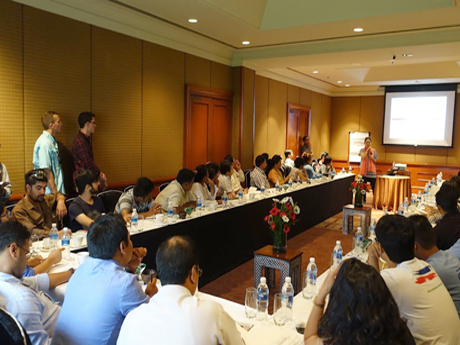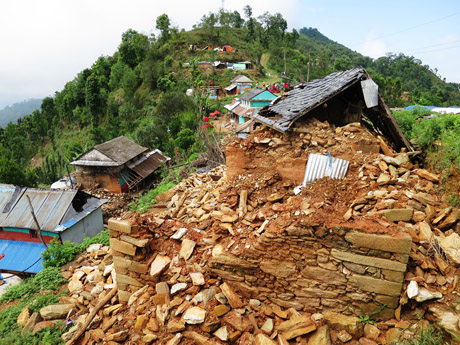A 3-person CCOUC team led by Prof. Emily Ying Yang CHAN visited Nepal on 14-18 June 2015, extending CCOUC’s network to Oxford University Clinical Research Unit – Nepal (OUCRU-NP), engaging the international and local disaster response sector in capacity building, and conducting technical assessments on the post-quake needs in suburban and rural communities to identify gaps and future response.
A 7.8-magnitude earthquake struck Nepal on 25 April 2015, followed by a 7.3-magnitude quake on 12 May 2015. CCOUC team arrived Kathmandu around one month after the second significant earthquake. While the disaster might have receded from the global spotlight, Nepalese still faces mounting challenge to rebuild their lives. In their stay, Prof. Emily Chan, Ms. Gloria Kwong Wai CHAN, Centre Manager of CCOUC, and Miss Carol Ka Po WONG, Programme Manager of CCOUC, visited various locations in Kathmandu, Lalitpur and Gorkha District.
A training on “Key Issues to Design and Implement Post-disaster Public Health and Medical Interventions for Asia in 21st Century” was conducted by Prof. Emily Chan in Kathmandu. 59 representatives from local and international NGOs, hospital management and academia joined the training with active participation.
A meeting with OUCRU-NP was carried out in Patan Hospital in Kathmandu, and a visit to the Nutritional Rehabilitation Home in Lalitpur, which adapted very well to expand its scope of work to cope with quake victims, was arranged by the Nepal Youth Foundation.
CCOUC team also conducted field-based assessment in the sub-urban community in Sankhu in Kathmandu District, and in the rural community in Finam, Gorkha District which is close to the epicenter of the first earthquake. After surviving through panic and stress out of the quake, the major issues that people displaced by the disaster faced were shelter and water and sanitation. Makeshift shelter made by tarpaulins and tin sheets could not stand for long especially in the monsoon season.
CCOUC team will be back to Nepal in the near future to work closely with NGOs on disaster resilience enhancement and public health education in rural communities. Cooperation among practitioners, academics and students is also expected to be fostered through partnerships and fellowships.
CCOUC would want to especially thanks Miss Rachana Shakya who worked with a local Nepali NGO and enrolled in the CCOUC online course “Public Health Principles in Disaster and Medical Humanitarian Response”. Rachana actively connected CCOUC to the local Nepali community, which provides vivid proof that our global online education network is effective to extend the community outreach.
 59 representatives from local and international NGOs, hospital management and academia joined a training on “Key Issues to Design and Implement Post-disaster Public Health and Medical Interventions for Asia in 21st Century” in Kathmandu. 59 representatives from local and international NGOs, hospital management and academia joined a training on “Key Issues to Design and Implement Post-disaster Public Health and Medical Interventions for Asia in 21st Century” in Kathmandu.  Villagers displaced from the earthquake live in makeshift shelters made with tarpaulins. |
 CCOUC team visited Pipalthok Village in Gorkha District with most of the houses totally collapsed. CCOUC team visited Pipalthok Village in Gorkha District with most of the houses totally collapsed. Prof. Emily Ying Yang Chan talked with the village head Mr. Topalo (left) in front of his collapsed house. |
 Prof. Emily Ying Yang Chan (front, first right) met with Dr. Buddha Basnyat (front, second right), Director of OUCRU-NP, in Patan Hospital in Kathmandu. Prof. Emily Ying Yang Chan (front, first right) met with Dr. Buddha Basnyat (front, second right), Director of OUCRU-NP, in Patan Hospital in Kathmandu. |
 The interior of the makeshift shelter is very primitive. |